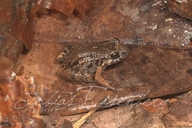|
Description
Males 17-20 mm, females 20-22 mm. About 70 % of individuals have dorsal coloration consisting of a brown background with numerous dark markings. Other individuals have a brown dorsum with two light dorsolateral stripes. There are two glandular dorsolateral folds on each side of the body, but they are difficult to see with the naked eye. The belly is white. The chin and throat, underside of arms, and underside of thighs are pinkish or grayish. The distance from the eye to the point of the snout is about the same as the width of the eye. Distribution and Habitat
Country distribution from AmphibiaWeb's database: Bolivia, Brazil, Colombia, Ecuador, French Guiana, Guyana, Peru, Suriname, Venezuela
Found commonly throughout the Reserva Florestal Adolpho Ducke in Brazil.Life History, Abundance, Activity, and Special Behaviors
Terrestrial, active by day and night. Juveniles eat collembolans, beetles and ants; adults eat crickets, beetles, spiders, centipedes and ants. Reproduction occurs in the rainy season, with a peak in December. Males usually call from the ground, hidden among leaves or fallen branches. Males excavate burrows in the soil, in which females deposit about 10 eggs in a foam nest. The tadpoles develop in the nest. Comments
Similar species: Adenomera hylaedactyla differs by the distance from the eye to the tip of the snout being one and a half times the diameter of the eye, and in having well-defined glandular dorsolateral folds that are easily seen with the naked eye, yellowish color on the front and lower surfaces of the thighs. Leptodactylus petersii differ by having dark ventral surfaces with irregular white spots.
Originally submitted by: Albertina P. Lima, William E. Magnusson, Marcelo Menin, Luciana K. Erdtmann, Domingos J. Rodrigues, Claudia Keller, Walter Hödl (first posted 2007-12-05)
Species Account Citation: AmphibiaWeb 2007 Adenomera andreae <https://amphibiaweb.org/species/3299> University of California, Berkeley, CA, USA. Accessed Jun 1, 2025.
Feedback or comments about this page.
Citation: AmphibiaWeb. 2025. <https://amphibiaweb.org> University of California, Berkeley, CA, USA. Accessed 1 Jun 2025.
AmphibiaWeb's policy on data use.
|
